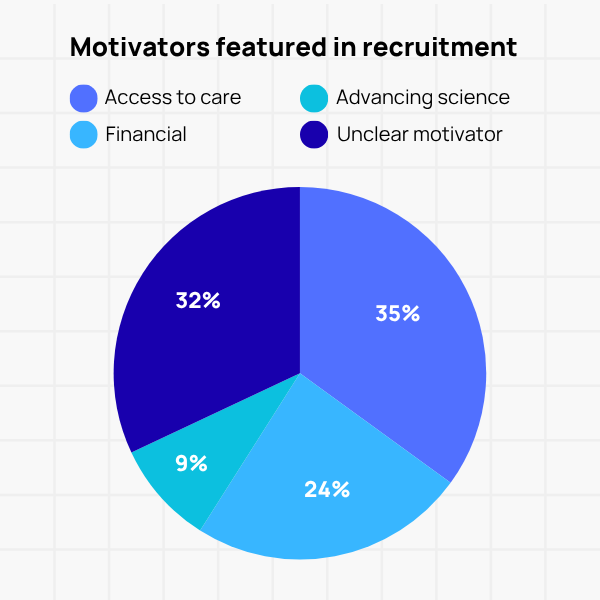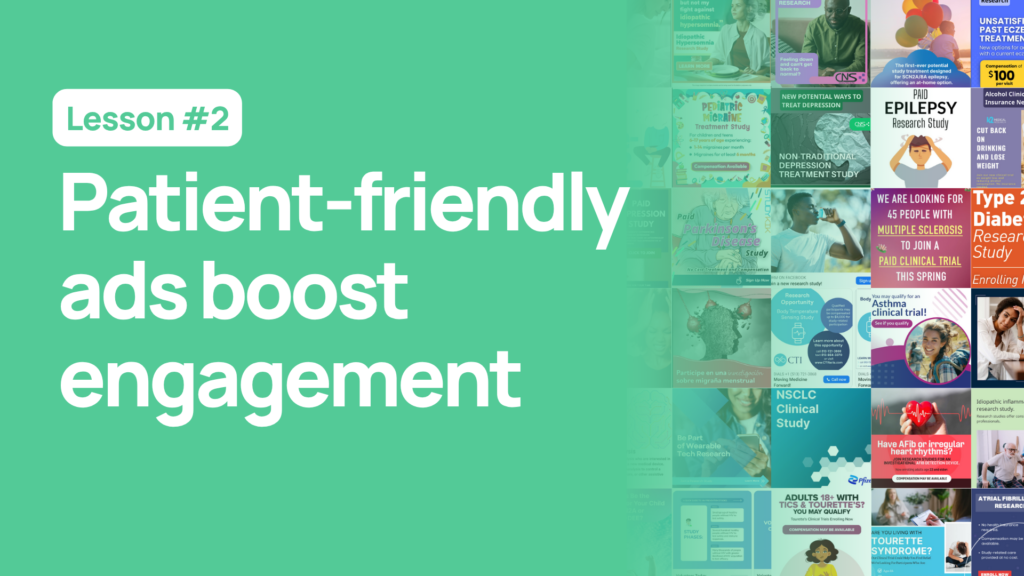Patients opt into trials for their own reasons.
This is just one lesson we learned!
Download the full eBook to explore all the insights we gained from analyzing 100 live patient recruitment ads.
The advantage of patient-friends recruitment
There’s no single story behind why someone joins a clinical trial. For some, it’s a search for hope when standard treatments have fallen short. Others are motivated by curiosity, a desire to advance science, or the simple wish to help others down the line. Financial compensation or access to care might play a role, but rarely the only one. What’s clear is that participation is deeply personal, shaped by each patient’s health journey, values, and trust in the people inviting them to take part.
Recognizing that complexity is key to better recruitment. When outreach assumes all patients are motivated by the same factors, messages fall flat. But when recruitment efforts reflect empathy and nuance, acknowledging diverse motivations and addressing real questions, patients feel seen and heard, not sold to.

The importance of standing out in today's digital world
Patients don’t join clinical trials simply to advance your research, they do it for their own reasons, grounded in personal experience and hope.
According to CISCRP’s Perceptions and Insights Study, the top motivations are clear: 62% of respondents said they participate to help advance science and treatments, 57% to help others with the same condition, 51% to obtain better treatment, and 42% to receive money. These results paint a picture of altruism and self-interest coexisting. Patients want to contribute to progress, but they also want meaningful benefits for themselves.

When we looked at the 100 recruitment ads in our analysis, that balance often got lost. Many ads overemphasized incentives or convenience while downplaying purpose and impact. Too few spoke to patients’ deeper motivations such as the desire to feel useful, hopeful, or part of something bigger than their diagnosis. The disconnect suggests an opportunity: when recruitment messaging reflects what actually drives patients to participate, rather than what we assume does, it resonates more powerfully and builds lasting trust.
Common themes in motivators for patient recruitment ads
Across hundreds of clinical trial recruitment ads, certain themes appear again and again. Whether highlighting hope for better outcomes, the chance to contribute to medical progress, or the appeal of convenience and compensation, these messages reveal what sponsors believe will motivate participation. But patterns also expose blind spots: too many ads lean on generic promises or transactional language, missing the emotional and informational cues patients actually respond to. By examining these recurring themes, we can better understand how to craft recruitment messaging that feels genuine, respectful, and aligned with what truly matters to patients.

Why this matters for patient recruitment
In reviewing 100 patient recruitment ads, we found that most leaned heavily on transactional motivators.
Access to care was the most common theme, appearing in 35% of ads, often framed as “no-cost medical care” or “access to new treatments.”
Financial incentives came next, featured in 24%, suggesting that many recruitment campaigns still assume money is the main driver.
Meanwhile, only 9% of ads focused on advancing science or helping others despite evidence that these altruistic motivators consistently rank highest among patients themselves.
Perhaps most concerning, 32% of ads didn’t clearly communicate any motivation at all, leaving potential participants unsure why they should care or how the study benefits them.
For biotech and pharma leaders, these findings highlight a clear gap between what companies emphasize and what patients value. When ads focus only on access or payment, participation becomes transactional instead of trust-based. Patients want meaning and partnership, not just compensation. By emphasizing purpose, we can move recruitment from persuasion to collaboration, building stronger enrollment and lasting trust.
How this looks with real-world patient recruitment ads

People aren’t just joining trials, they’re looking for care. When ads clearly communicate access to treatment, diagnostics, or specialist support, they tap into one of the strongest motivators for participation.
When patients know what they’ll gain, they’re more likely to engage. Being up-front about financial incentives shows respect for patients’ time and signals transparency, which are two key drivers of trust and engagement.
Patients are more likely to engage with recruitment ads when they feel they’re contributing to progress. Center it in your messaging, and you’ll connect with people who want to make a difference.





